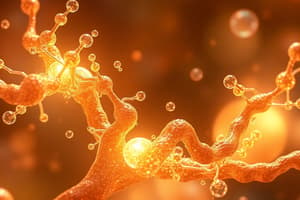Podcast
Questions and Answers
Which unit is commonly associated with the measurement of length in the Imperial system?
Which unit is commonly associated with the measurement of length in the Imperial system?
- Kilogram
- Kilometer
- Inch (correct)
- Celsius
What is a derived quantity that combines base quantities?
What is a derived quantity that combines base quantities?
- Speed (correct)
- Time
- Mass
- Temperature
Which attitude is essential for scientific inquiry and encourages the exploration of multiple solutions?
Which attitude is essential for scientific inquiry and encourages the exploration of multiple solutions?
- Objectivity
- Intellectual Honesty
- Open-Mindedness (correct)
- Critical Thinking
Which of the following is not a fundamental quantity?
Which of the following is not a fundamental quantity?
In the Atwater System, how is the energy content of food expressed?
In the Atwater System, how is the energy content of food expressed?
What is the primary function of carbohydrates in the body?
What is the primary function of carbohydrates in the body?
Which monosaccharide is commonly known as 'fruit sugar'?
Which monosaccharide is commonly known as 'fruit sugar'?
What type of carbohydrate is formed by two monosaccharides joined together?
What type of carbohydrate is formed by two monosaccharides joined together?
How is a glycosidic bond formed?
How is a glycosidic bond formed?
What role do polysaccharides play in plants?
What role do polysaccharides play in plants?
What type of reaction occurs when a disaccharide is broken down into monosaccharides?
What type of reaction occurs when a disaccharide is broken down into monosaccharides?
Which of the following best describes monosaccharides?
Which of the following best describes monosaccharides?
What is a key characteristic of carbohydrates concerning water potential?
What is a key characteristic of carbohydrates concerning water potential?
What type of bond holds starch molecules together?
What type of bond holds starch molecules together?
Which of the following statements about cellulose is true?
Which of the following statements about cellulose is true?
What is the primary storage form of carbohydrates in mammals?
What is the primary storage form of carbohydrates in mammals?
What type of fat has no double bonds between carbon atoms?
What type of fat has no double bonds between carbon atoms?
Which type of lipid is essential for cell membrane structure?
Which type of lipid is essential for cell membrane structure?
What effect do trans fats have on cholesterol levels?
What effect do trans fats have on cholesterol levels?
Which fatty acid type is liquid at room temperature?
Which fatty acid type is liquid at room temperature?
What is the primary composition of lipids?
What is the primary composition of lipids?
What is the primary function of enzymes in biological systems?
What is the primary function of enzymes in biological systems?
Which type of protein is responsible for sending signals that regulate body functions?
Which type of protein is responsible for sending signals that regulate body functions?
Which of the following best describes the composition of amino acids?
Which of the following best describes the composition of amino acids?
What role do structural proteins play in the body?
What role do structural proteins play in the body?
Which statement about proteins is true?
Which statement about proteins is true?
What is an example of a transport protein and its function?
What is an example of a transport protein and its function?
How are proteins obtained from dietary sources?
How are proteins obtained from dietary sources?
Which characteristic distinguishes one amino acid from another?
Which characteristic distinguishes one amino acid from another?
What is the main distinction between accuracy and precision in measurements?
What is the main distinction between accuracy and precision in measurements?
Which of the following best describes the role of a legend in a graph?
Which of the following best describes the role of a legend in a graph?
What does a pie graph primarily display?
What does a pie graph primarily display?
In the context of scientific inquiry, which statement about the limitations of science is accurate?
In the context of scientific inquiry, which statement about the limitations of science is accurate?
Which of the following statements is true regarding data tables?
Which of the following statements is true regarding data tables?
What is one key feature of graphs that ensures accurate representation of data?
What is one key feature of graphs that ensures accurate representation of data?
Which measurement system is widely recognized as the modern metric system based on powers of 10?
Which measurement system is widely recognized as the modern metric system based on powers of 10?
What characteristic defines a line graph?
What characteristic defines a line graph?
What role do transport proteins play in the plasma membrane?
What role do transport proteins play in the plasma membrane?
What is the primary function of defense proteins, such as antibodies?
What is the primary function of defense proteins, such as antibodies?
Which domain of science emphasizes scientific inquiry and the importance of evidence?
Which domain of science emphasizes scientific inquiry and the importance of evidence?
Which aspect of scientific enterprise involves the generation of scientific knowledge through experiments and observations?
Which aspect of scientific enterprise involves the generation of scientific knowledge through experiments and observations?
What does the 'Understanding World' concept in the scientific worldview suggest?
What does the 'Understanding World' concept in the scientific worldview suggest?
Which of the following describes a characteristic of scientific knowledge?
Which of the following describes a characteristic of scientific knowledge?
What is the process by which scientists refine results and discover new insights called?
What is the process by which scientists refine results and discover new insights called?
What is a misconception about the 'Methods of Science' concept?
What is a misconception about the 'Methods of Science' concept?
Flashcards
Carbohydrate
Carbohydrate
A compound made up of carbon, hydrogen, and oxygen, with a 2:1 ratio of hydrogen to oxygen. Used for energy and structure.
Monosaccharide
Monosaccharide
Simple sugar that's the building block of other, more complex carbohydrates.
Disaccharide
Disaccharide
Sugar composed of two monosaccharides linked together by a glycosidic bond.
Polysaccharide
Polysaccharide
Signup and view all the flashcards
Glycosidic bond
Glycosidic bond
Signup and view all the flashcards
Dehydration reaction
Dehydration reaction
Signup and view all the flashcards
Hydrolysis
Hydrolysis
Signup and view all the flashcards
Glucose
Glucose
Signup and view all the flashcards
What is a carbohydrate made of?
What is a carbohydrate made of?
Signup and view all the flashcards
What are the functions of carbohydrates?
What are the functions of carbohydrates?
Signup and view all the flashcards
What is a glycosidic bond?
What is a glycosidic bond?
Signup and view all the flashcards
What is starch?
What is starch?
Signup and view all the flashcards
What is cellulose?
What is cellulose?
Signup and view all the flashcards
What is glycogen?
What is glycogen?
Signup and view all the flashcards
What are lipids made of?
What are lipids made of?
Signup and view all the flashcards
What are the major types of lipids?
What are the major types of lipids?
Signup and view all the flashcards
Phospholipid bilayer
Phospholipid bilayer
Signup and view all the flashcards
Proteins
Proteins
Signup and view all the flashcards
Amino acids
Amino acids
Signup and view all the flashcards
Enzymes
Enzymes
Signup and view all the flashcards
Messenger Proteins (Hormones)
Messenger Proteins (Hormones)
Signup and view all the flashcards
Structural Proteins
Structural Proteins
Signup and view all the flashcards
Transport Proteins
Transport Proteins
Signup and view all the flashcards
Hemoglobin
Hemoglobin
Signup and view all the flashcards
Scientific Knowledge
Scientific Knowledge
Signup and view all the flashcards
Limitations of Science
Limitations of Science
Signup and view all the flashcards
Accuracy
Accuracy
Signup and view all the flashcards
Precision
Precision
Signup and view all the flashcards
Data Table
Data Table
Signup and view all the flashcards
Pie Graph
Pie Graph
Signup and view all the flashcards
Bar Graph
Bar Graph
Signup and view all the flashcards
Line Graph
Line Graph
Signup and view all the flashcards
SI Units
SI Units
Signup and view all the flashcards
Derived Quantities
Derived Quantities
Signup and view all the flashcards
Intellectual Honesty
Intellectual Honesty
Signup and view all the flashcards
Open-Mindedness
Open-Mindedness
Signup and view all the flashcards
Atwater System
Atwater System
Signup and view all the flashcards
Defense proteins
Defense proteins
Signup and view all the flashcards
Science as a Way of Knowing
Science as a Way of Knowing
Signup and view all the flashcards
Science as a Way of Doing
Science as a Way of Doing
Signup and view all the flashcards
Science as a Way of Looking
Science as a Way of Looking
Signup and view all the flashcards
Demands Evidence
Demands Evidence
Signup and view all the flashcards
Explains and Predicts
Explains and Predicts
Signup and view all the flashcards
Identify and Avoid Bias
Identify and Avoid Bias
Signup and view all the flashcards
Study Notes
Carbohydrates
- Carbohydrates are compounds primarily composed of carbon, oxygen, and hydrogen.
- The hydrogen and oxygen atoms in carbohydrates have a 2:1 ratio.
- Carbohydrates are a source and storage of energy, used as fuel for the body, specifically the brain and muscles.
- Carbohydrates are also crucial for structural functions in plant cell walls.
- Carbohydrates help regulate blood sugar levels.
Biological Functions of Carbohydrates
- Carbohydrates provide a rigid structure in plants.
- Carbohydrates are sweet and soluble in water.
- They lower water potential by increasing solute concentration, leading to water movement through osmosis.
- Carbohydrates are a primary energy source during short bursts of activity.
Monosaccharides
- Monosaccharides are the fundamental building blocks, or monomers, of carbohydrates.
- They are simple sugars that cannot be broken down into simpler sugars.
- Glucose is a monosaccharide found in blood, acting as the body's main energy source.
- Fructose is a monosaccharide commonly found in fruits, vegetables, and honey.
- Galactose is a monosaccharide naturally found in mammalian milk and milk products.
Disaccharides
- Disaccharides are composed of two monosaccharides joined by a dehydration reaction.
- The bond between monosaccharides is called a glycosidic bond.
- The glycosidic bond is formed through a dehydration reaction, releasing water as a product.
- Maltose, sucrose, and lactose are examples of disaccharides.
- A glycosidic bond can be broken by hydrolysis, requiring water and resulting in two monosaccharides.
Polysaccharides
- Polysaccharides are complex carbohydrates made up of numerous monosaccharide units linked together.
- These molecules are formed through multiple dehydration reactions.
- The bonds that hold polysaccharides together are glycosidic bonds.
- Starch is the primary energy storage form in plants, found in roots, fruits, and seeds.
- Cellulose is the structural component of plant cell walls.
- Glycogen is the storage carbohydrate in animals, primarily in the liver and muscles.
Studying That Suits You
Use AI to generate personalized quizzes and flashcards to suit your learning preferences.





